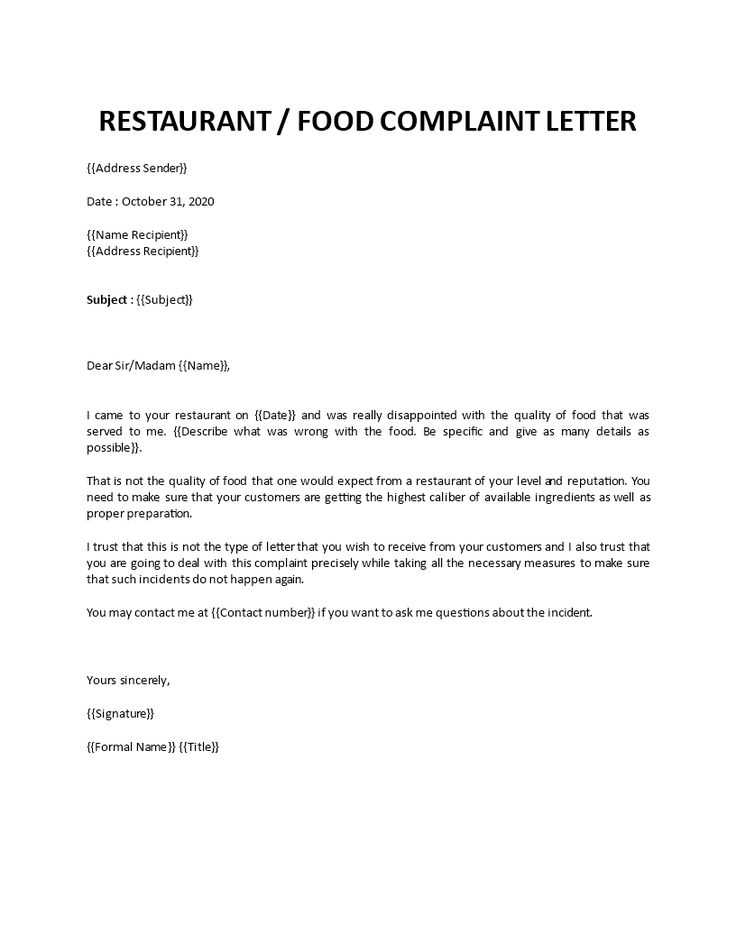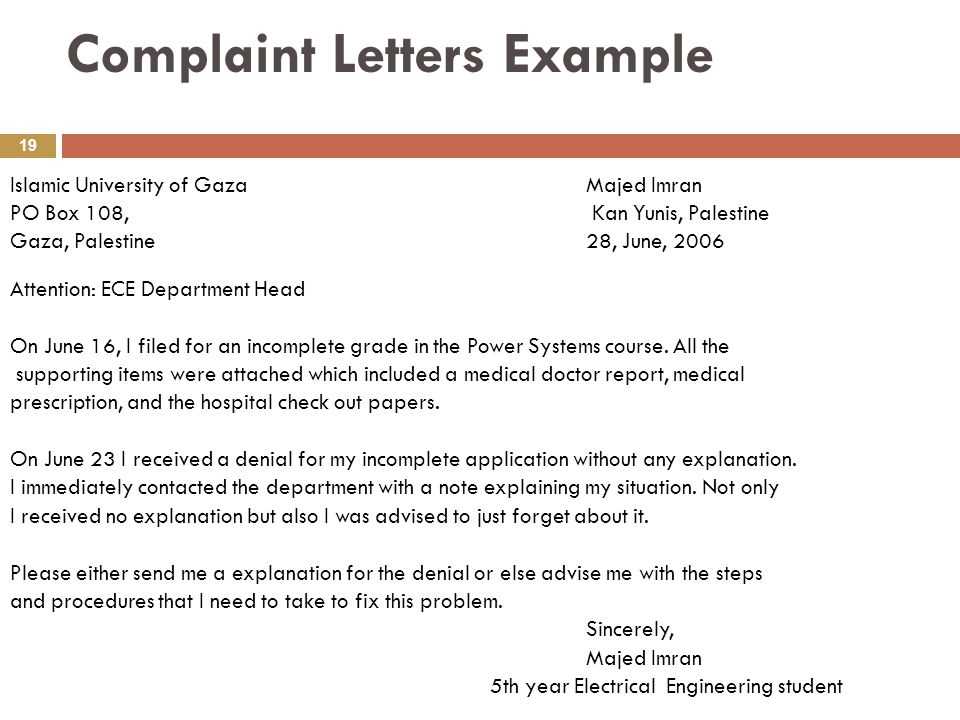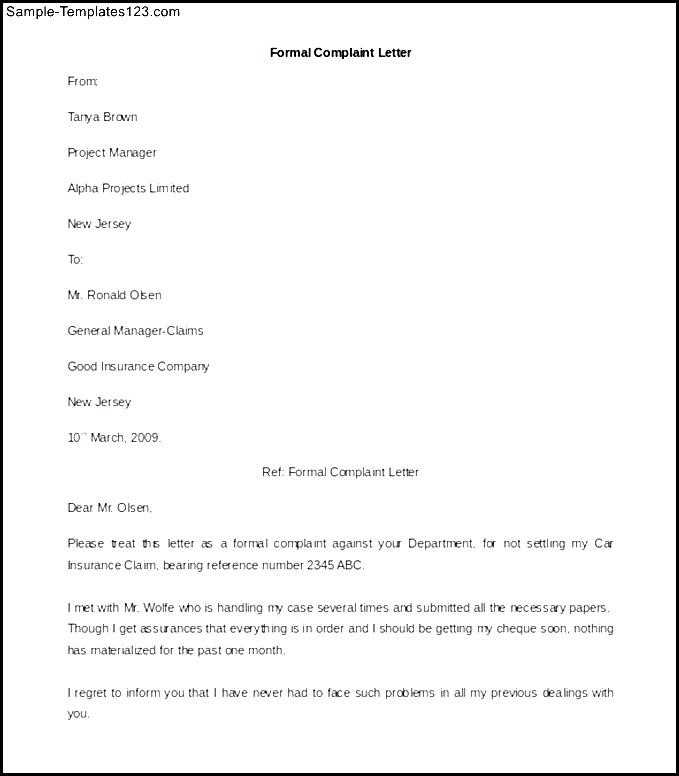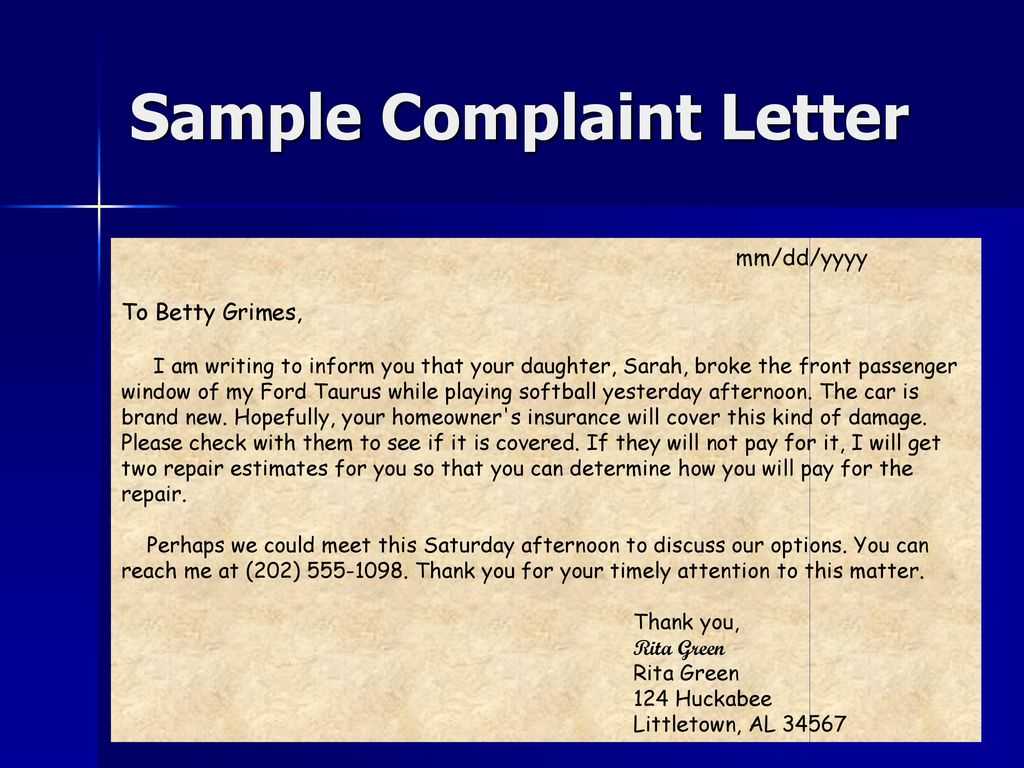Used car complaint letter template

If you have encountered issues with a used car you recently purchased, writing a clear and structured complaint letter is crucial to resolving the matter efficiently. A well-organized letter can help you express your concerns and expectations while maintaining professionalism. Here is a template to guide you in drafting a letter that addresses your issue effectively.
Begin by outlining the specifics of your purchase. Mention the make, model, and year of the car, along with the purchase date and location. Include the name of the dealership or seller and any relevant reference number or order details. Providing these details ensures the recipient can quickly identify your case.
Be specific about the problem. Describe the issue with the vehicle in clear terms. Include any symptoms, breakdowns, or defects you’ve noticed, and specify when they occurred. If applicable, mention any repair attempts or services already conducted. Offering precise information helps the reader understand the severity and urgency of the situation.
State your desired resolution. Whether you seek a refund, repair, or replacement, make your expectations clear. Explain how you want the seller to address the issue, and if possible, reference any warranties or guarantees that cover the situation. Being direct about your needs speeds up the resolution process.
Conclude with a polite but firm request for a timely response. Include your contact details and express your willingness to discuss the matter further if needed. A courteous yet assertive tone encourages a positive outcome.
Used Car Complaint Letter Template
When you purchase a used car and encounter issues, it’s crucial to address them promptly with the seller. Below is a template to help you draft a complaint letter that outlines your concerns clearly and professionally.
Subject: Complaint Regarding Used Car Purchase – [Car Model and Year]
Dear [Dealer’s Name or Company Name],
I am writing to formally address concerns regarding a used car I purchased from your dealership on [purchase date]. The car in question is a [make, model, year], and the vehicle identification number (VIN) is [VIN number]. Shortly after the purchase, I began experiencing issues with [describe the specific problem, e.g., engine malfunction, faulty brakes, etc.]. These problems were not disclosed at the time of sale, and I believe they are significant enough to warrant immediate attention.
I have taken the car to a certified mechanic, and their assessment confirms that [explain the findings]. Given the nature of these issues, I request the following action be taken: [list desired resolutions such as a full refund, replacement, or repair]. According to the terms outlined in the purchase agreement and any applicable warranty, I am entitled to have these issues resolved within a reasonable timeframe.
Attached are the relevant documents, including the original purchase receipt and the mechanic’s report, for your reference. Please advise me on the next steps within [time frame, e.g., 10 business days] to ensure that this matter is addressed without further delay.
Thank you for your attention to this matter. I look forward to your prompt response and resolution of this issue.
Sincerely,
[Your Full Name]
[Your Contact Information]
[Your Address]
How to Structure Your Complaint Letter for a Used Car
Begin your letter with a clear and concise introduction. State your purpose right away, including the date of purchase and the make, model, and year of the car. Mention any warranty or service agreements that may be relevant to your complaint.
Describe the issue in detail. Provide a timeline of events, from the moment you first noticed the problem to any attempts to address it. Be specific about any repairs, parts, or services promised by the seller that were either not delivered or failed to resolve the issue.
Include any supporting documentation such as receipts, repair estimates, or communication with the seller. This strengthens your position and shows you’ve kept track of the situation.
Clearly state what you expect as a resolution. Whether it’s a refund, repair, or replacement, being direct will help avoid confusion and set the tone for how the issue should be resolved.
Close the letter with a request for a timely response, specifying a reasonable deadline for resolution. End by thanking the recipient for their attention to the matter.
What to Include in the First Paragraph of Your Complaint
Begin with a clear statement of the issue you are addressing. Mention the car’s make, model, and year, along with any identifying information such as the VIN number or purchase date. Specify the problem you’ve encountered, whether it’s a mechanical failure, cosmetic damage, or an issue related to the seller’s representation of the car. Being specific helps the recipient quickly understand your complaint.
Provide Context
Next, offer a brief context for the situation. Include the circumstances under which you discovered the issue, whether it was during the first test drive, after taking the car home, or after a few weeks of use. This adds credibility to your complaint and helps the reader better understand the timeline.
State Your Expectations
Conclude the first paragraph by briefly stating what you expect as a resolution. Whether you’re asking for a refund, repair, or replacement, being direct about your desired outcome sets the tone for the rest of your letter. This ensures the recipient knows what action you are requesting right from the start.
Key Details to Mention About the Car’s Condition
Provide accurate and specific details about the car’s current state to avoid misunderstandings. Here’s what to include:
1. Mechanical Issues
- Note any problems with the engine, transmission, or brakes.
- Describe any unusual sounds, vibrations, or performance issues.
- If repairs were made, mention the parts replaced and the reason behind it.
2. Exterior and Interior Condition
- Detail any visible damage, such as scratches, dents, or rust on the body or frame.
- Include the condition of the paint job and whether any parts have been repainted.
- Describe the state of the tires, windshield, and mirrors, noting any chips or cracks.
- For the interior, mention the condition of the seats, dashboard, controls, and upholstery. Point out any wear or stains.
3. Mileage and Service History
- Clearly state the car’s current mileage, as this can affect its value and condition assessment.
- List any major services completed, such as oil changes, tire rotations, or brake replacements.
- If the car has had any accidents, be transparent about the damage and repairs.
4. Electrical and Technological Systems
- Mention the working condition of key electronic components, like air conditioning, lights, and the radio.
- Address any issues with the car’s electrical systems, such as power windows or malfunctioning sensors.
How to Describe Your Previous Communication with the Seller
Clearly explain all interactions you had with the seller. Start by outlining the method of communication, such as phone calls, emails, or messages. Specify dates and times, if possible, to give a clear timeline of events. Avoid vague statements–be as precise as possible.
Example of Previous Communication
Provide examples of key exchanges that show your concerns or the promises made by the seller. For instance, if the seller assured you a certain feature would be included or fixed before purchase, mention that statement directly. Include any responses you received from them.
| Date | Method of Communication | Summary of Communication |
|---|---|---|
| January 10, 2025 | Seller confirmed the car had a new transmission. | |
| January 15, 2025 | Phone Call | Seller promised to fix the brakes before delivery. |
| January 20, 2025 | Text Message | Seller assured me the car had passed all safety checks. |
Addressing Miscommunication
If any misunderstanding or miscommunication occurred, state how the issue was raised and what the seller’s response was. Make sure to focus on how the seller reacted to your concerns and if they took any steps to resolve the issue.
What Action You Expect from the Seller
Request a prompt resolution of the issue at hand. Clearly state what you want to be done, whether it’s a refund, replacement, or necessary repairs. Specify deadlines for the seller to act, and mention the preferred method of communication for follow-ups. Make sure you remain firm, yet polite, in outlining your expectations.
Refund or Replacement
If the car has significant issues that cannot be fixed easily, request a full refund or a replacement vehicle. Be clear about the timeframe in which you expect the action to be taken. Mention that you expect the seller to cover all associated costs, such as transportation or repair fees.
Repairs and Warranty

If repairs are required, make sure the seller takes full responsibility. Ask for the repairs to be conducted by a certified mechanic, and request a guarantee that the problem will not recur. Keep the lines of communication open, and ask for regular updates on the repair process.
Tips for Following Up if You Don’t Receive a Response

If you haven’t received a reply after sending your initial complaint letter, don’t hesitate to follow up. Here are some practical steps to take to keep your issue moving forward:
1. Send a Polite Reminder

Give the recipient some time to review your complaint, but follow up after 7-10 days if you haven’t heard back. Keep your tone polite and professional in your reminder email or letter. Reference your original letter and mention that you’re waiting for a resolution or response.
2. Be Specific About Your Expectations
In your follow-up, clearly state what you expect from the recipient. Whether it’s a refund, replacement, or more information, let them know how you would like the situation to be addressed. This helps them understand your needs and speeds up the resolution process.
- Example: “I would appreciate it if you could provide an update on my request for a refund for the vehicle purchase.”
- Example: “Could you please inform me about the next steps in processing my complaint?”
3. Use Multiple Communication Channels
If email hasn’t worked, try reaching out through other means like phone calls or social media. Some companies are quicker to respond on their social media platforms or customer service lines. Just make sure to keep a record of all your communications for reference.
4. Keep It Brief
When following up, avoid writing long messages. Stick to the key points and remain focused on the issue at hand. A concise follow-up is more likely to grab attention than a lengthy explanation.
5. Show Persistence Without Being Pushy
Don’t be afraid to follow up more than once if necessary. However, avoid sounding aggressive or impatient. Remain courteous, and remind them of the urgency of resolving your issue. If possible, provide specific dates or timelines for resolution.
- Example: “I hope to hear back from you within the next week so we can resolve this matter promptly.”
6. Know When to Escalate
If after several attempts you still haven’t received a response, it might be time to escalate the matter. Reach out to a higher level of authority within the company or file a complaint with a regulatory body. Always ensure you’ve documented all your prior communication for reference.